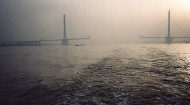![]()
![]()


![]()
![]()
The next morning dawned sunny and clear and I arose by 6:30am. With two cameras in hand (SLR and handy-cam video), I did not want to miss a moment of this great journey. I arrived on deck just as a huge, half-completed suspension bridge was looming ahead. We had just passed the city of Zhenjiang in Jiangsu province and, at this point, any bridge traversing the Yangzi needed to be at least two miles long. This amounted to a major engineering feat considering the fast flow, depth and widely fluctuating levels of the river it spanned. It was the first of several impressive bridges that we would see. Decked out in cranes and with its centre span still to be inserted, it made for an awesome sight in the misty first light of the morning.
The river here was surrounded by low-lying hills and the course of the ferry brought us close enough to the shore to witness locals practicing taiji under secluded trees and in an open-walled Buddhist temple. On the river itself were dozens of tiny sampans, their human occupants often tending to fishing nets and long lines.
Half an hour later, the throbbing industrial city of Nanjing emerged from the thick, oily smog that always seems to hang menacingly over urban centres in China.
With a population of over four million people, the city is infamous in Chinese history on two accounts. It was here that the first Opium War concluded in 1841 with the signing of the Treaty of Nanjing. Not only ensuring the future of the opium trade, the treaty opened up the Yangzi River to foreign trade and ceded Hong Kong to the British as a spoil of war. Almost a hundred years later, during Japanese occupation of the city in the late 1930s and early 1940s, up to 300,000 people were slaughtered in the city during what is commonly now called the Nanjing Massacre. Chinese citizens were raped, experimented upon like laboratory rats or simply executed and buried in mass-graves. The bare details of what took place make for hideous reading.
We passed under the span of Nanjing’s Yangzi Bridge and, after a ten minute stop at the city’s rustic little ferry terminal, we continued upstream.
We often passed close enough to the shoreline to watch the many labourers toiling on the river banks. Usually they would be helping to transport aggregate of various kinds onto barges for use downstream. In some places they were building the river banks higher into dike-like containment walls to hold at bay the Yangzi when in flood mode.
At other times we could make out workers in the fields, tending either to crops or livestock. Always there were fishermen in tiny boats, checking their nets for meager catches.
In mid afternoon we stopped briefly at the river city of Wuhu and by dusk had reached Tongling.
Turning in for bed that evening, we were kept awake by regular announcements over the public address system. Weiping translated them for me…they were announcing karaoke sessions at the back of the boat and an obscure Hong Kong action movie in the forward lounge directly above us. The irritating announcements continued for so long that I was tempted to march upstairs and turf their flaming video-disk player into the river.
The television weather forecast that night had shown a rain front was approaching. We drifted off to sleep not knowing quite what to expect the next day.